

The Advertising Standards Agency (ASA) has ordered EE not to reprint an advert that claimed its fixed line broadband services was Britain’s “most reliable” since such boasts could not be substantiated.
The claim was made in a mailing campaign that introduced “Britain’s most reliable broadband for staying connected,” followed by small print which referenced an Ofcom report on fixed-line broadband performance published in May 2013. It stated that EE customers experienced less latency and jitter than a number of other ISPs.
“This means that EE is good for real time services such as Skype, video calling and gaming,” stated the small print, but BT objected to all of the claims made in the advert, arguing that the Ofcom report in question did not refer to any direct measurement of connectivity and that EE did not score higher than BT to “any statistically significant degree.”
EE responded by saying that Ofcom’s report stated that the three measurements – low packet loss, latency and jitter – were a good indication of the reliability of the connection needed for services used by an average consumer to communicate with their friends and family, and that this was implied in the body text of the advert.
The company also said it provided footnotes for the Ofcom report that would allow consumers to validate EE’s claims and in no way implied that the claims applied to router connectivity.
However the ASA disagreed, explaining that the advert simply said “better home broadband”, and that the text in the body that justified such claims on the basis of real time applications was not obvious enough.
“We considered that that text was not sufficiently prominent, and that most consumers reading the ad would understand the claim to mean that EE offered the most reliable broadband in terms of maintaining a broadband connection and had lower drop-off rates than their competitors, enabling customers to ‘stay connected’,” said the ASA.
“Therefore, we considered that to substantiate the claim, EE needed to provide evidence to show that the maintenance of an EE broadband connection was superior to other ISPs.”
The ASA also noted that the graphs EE relied on to justify its claim showed that EE scored lower than some competitors and also ruled that consumers would believe the claims to mean a connection to an Internet-connected device – not just to the router.
The advert must not appear again in its current form and the ASA says EE must have sufficient evidence to substantiate future claims. EE has accepted the ruling.
“The claims in our ad were based on a recent broadband report from Ofcom in which EE scored higher than other providers, including BT, on latency, packet loss and jitter, but not to a sufficient statistical degree.,” a spokesperson told TechWeekEurope. “We accept the ASA’s ruling however and will amend the ad accordingly.”
BT also objected to another EE advertisement, this time online, which claimed the firm’s Brightbox 2 router was the “first ‘plug and play’ Fibre Broadband Router in the UK.” BT said this was misleading and could not be substantiated, however the ASA said this was a valid claim as although BT’s HomeHub 5 router had self-install technology, this had not been enabled, whereas it had been in the Brightbox 2.
Earlier this month, BT itself was in trouble with the ASA, which ruled the former state monopoly had been providing false speed estimates.
Tesla sales have plummeted to lowest level in three years, as deliveries of new EVs…
New addition. Next generation foundation model, as Amazon Nova model launches to perform actions within…
Head of artificial intelligence research at Meta Platforms has announced she is leaving the social…
No decision yet, after media reports CK Hutchison was to spin off its global telecom…
Ahead of 5 April deadline, Trump is to hold White House meeting over possible investors…
Apple fined 150m euros over App Tracking Transparency feature that it says abuses Apple's market…